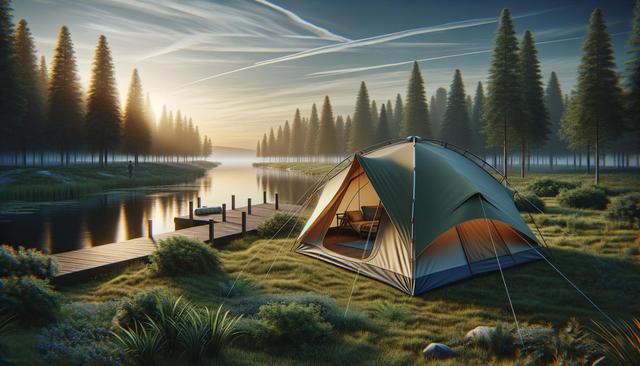Understanding Tent Categories
Outdoor tents come in various categories tailored to different environments and usage levels. For beginners, basic three-season tents are suitable for spring, summer, and fall, offering a balance between ventilation and weather protection. These tents are typically lightweight and easy to set up, making them ideal for casual camping trips. Four-season tents, on the other hand, are built for harsh winter conditions and are designed to withstand snow loads and strong winds. Mountaineering tents fall into this category and are often used by professionals tackling high-altitude expeditions. There are also ultralight tents developed for long-distance hikers who prioritize minimal weight without compromising shelter quality. Common tent types include:
- Dome tents: Stable and easy to pitch, great for general camping.
- Tunnel tents: Offer more interior space, best for group camping.
- Geodesic tents: Highly stable structures, ideal for extreme conditions.
- Pop-up tents: Convenient for quick setups, suitable for festivals or short trips.
Understanding what each category offers will help in narrowing down choices based on your specific outdoor activity and climate expectations.
Key Factors in Tent Selection
When purchasing an outdoor tent, several selection criteria should be considered to ensure it meets your needs. First, evaluate the size and capacity. Tents are rated by the number of occupants they can hold, but it’s wise to size up if you need extra space for gear. Material quality is another crucial factor. Look for durable fabrics like ripstop nylon or polyester and check the waterproof rating (measured in millimeters). A tent with a rainfly and sealed seams offers better protection against moisture. Additional factors to consider include:
- Weight: Important for backpackers, lighter tents reduce fatigue.
- Ventilation: Mesh panels and vents prevent condensation build-up.
- Setup complexity: Freestanding tents are easier to pitch than non-freestanding models.
- Portability: Compact packing size makes transportation easier.
These elements combined will help you find a tent that aligns with your outdoor goals, whether you’re embarking on a weekend hike or a multi-week expedition.
Design Features and Materials
Modern outdoor tents incorporate advanced materials and construction techniques to enhance performance. Tent poles are commonly made from aluminum or fiberglass, with aluminum offering superior strength and durability. Some high-end models use carbon fiber for weight reduction. The tent body often includes mesh sections for airflow and visibility, while the rainfly provides an extra layer of protection. Floor materials should be waterproof and abrasion-resistant, often treated with polyurethane coatings. Zippers, guy lines, and stake loops are also designed to endure regular use and exposure. Popular design enhancements include:
- Color-coded poles and clips for quicker setup.
- Vestibules for gear storage without crowding the sleeping area.
- Multiple doors for easier access and ventilation.
- Built-in light holders or gear lofts for added convenience.
Understanding these features can help you assess the quality and practicality of a tent, especially when comparing multiple options in the same category.
Tips for Tent Setup and Usage
Proper setup and use of your outdoor tent can significantly improve its performance and lifespan. Start by choosing a flat, dry spot free of sharp rocks or branches. Use a groundsheet or footprint to protect the tent floor from abrasion and moisture. When pitching the tent, follow manufacturer instructions carefully, ensuring all lines are taut and stakes are securely driven into the ground. In windy conditions, use guy lines and extra stakes for better stability. To maximize comfort and efficiency during your trip:
- Keep the interior organized with storage pockets and gear lofts.
- Ventilate daily to reduce condensation buildup.
- Avoid storing food inside the tent to deter wildlife.
- Keep zippers clean and operate them gently to avoid damage.
Practicing setup at home before your trip can save time and prevent frustration in the field, especially if you’re using a new or complex model for the first time.
Maintenance and Storage Tips
Maintaining your tent properly ensures it remains reliable for future adventures. After each trip, clean the tent with a soft brush or sponge and mild soap. Avoid machine washing or drying, as this can damage waterproof coatings. Always dry the tent completely before packing it away to prevent mold and mildew. Store it loosely in a cool, dry place rather than tightly stuffed in its sack for extended periods. Periodically inspect for wear and tear, checking seams, zippers, and fabric integrity. Additional maintenance tips include:
- Reapplying waterproofing treatments as needed, especially on the rainfly and floor.
- Repairing small tears with patch kits to prevent them from worsening.
- Replacing damaged poles or stakes to maintain structural integrity.
With regular care, even lightweight or high-use tents can offer many years of dependable service, making them a solid investment for all levels of outdoor enthusiasts.
Conclusion: Choosing the Right Tent for Your Adventure
Whether you’re just beginning your journey into outdoor exploration or are a seasoned adventurer, choosing the right tent is an important decision that affects your overall experience. By understanding the different categories, carefully evaluating selection criteria, and maintaining your equipment properly, you can ensure your tent serves you well in various environments. A well-chosen tent not only provides shelter but also enhances comfort, safety, and enjoyment in the outdoors. Take time to assess your specific needs and match them to the features and functions available to make your next outdoor excursion more rewarding and secure.








